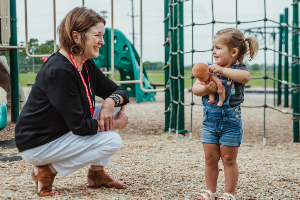
Education is the great equalizer.
Shared often by one of her former principals, that paraphrase remains top of mind for CASA volunteer and former educator, Teresa Cornett. Having spent 18 years as an elementary teacher, Teresa knew CASA would be a good outlet for her experience, knowledge, and passions when she retired in 2017. As kids return to school this month, we thought it might be helpful to share the many ways that CASA volunteers impact their children’s educational success. Teresa was gracious enough to answer a few questions for us.
Q. Did you have any students who were in foster care when you were a classroom teacher?
A. Yes. It’s hard to teach kids when you know they are transient. But, being a good teacher and human, you know you need to help as long as they are with you. It was very difficult to see kids come and go from the classroom and know they were facing an uphill battle from learning loss – both prior to coming into care and from being moved around a lot while in care.
Q. What do all students need?
A. Well, that’s easy. They need to feel safe. Their physical and emotional safety is number one. No one can be successful in a classroom if they are afraid and not secure in their surroundings. They also need their physical needs met; they can’t be malnourished, for example. Lastly, they need to trust their teacher and the adults around them. This is the same for my CASA kids as it was for my students. I am constantly reminding the young people I serve that “I’m here for you.”
Q. What are three simple things advocates can do to make a difference in a child’s education?
A. 1) Communicate with their teacher! Via email, chat, or by attending parent-teacher conferences. Let the teacher know you will follow through, and they’ll communicate with you. They’ll keep you updated on testing, missing forms, homework, supply needs, etc.
2) Check in on attendance, report cards, and units. This is extremely important, especially for our older youth who haven’t been in school consistently.
3) Meet the needs of your child by appreciating where they are. Not every child is working toward college. If your young person is looking for alternatives or is focused on completing their GED, lay out the benefits of their path and encourage them to succeed.

Q. Describe a specific time when, as a CASA, you were able to advocate for a child’s academic success.
A. Every child needs something different. That said, I’ve verified attendance for when a child struggled getting to school. I’ve helped advocate for a laptop for another. I’ve worked with a young person who was interested in a career in cosmetology to make sure she had enough credits to obtain her GED. And, I’ve advocated for one of my young people, with special needs, to access life skills from a community partner.
Q. Current or former teachers seem uniquely qualified to become CASA volunteers. What makes them so?
A. Obviously, teachers know how to work with children, but they also know how to work the educational system. Teachers can easily navigate requests for accommodations, additional therapies, and counseling at school. For the older kids, they also know how the unit system works and can make sure the young person is working with their guidance counselor or academic advisor to graduate and participate in career planning.
Beyond specifically educational advocacy, every effort an advocate can make to move these children out of survival mode opens them up to the freedom to think about the future.
What a gift to give, Teresa. Thank you for your years of service and commitment to children.